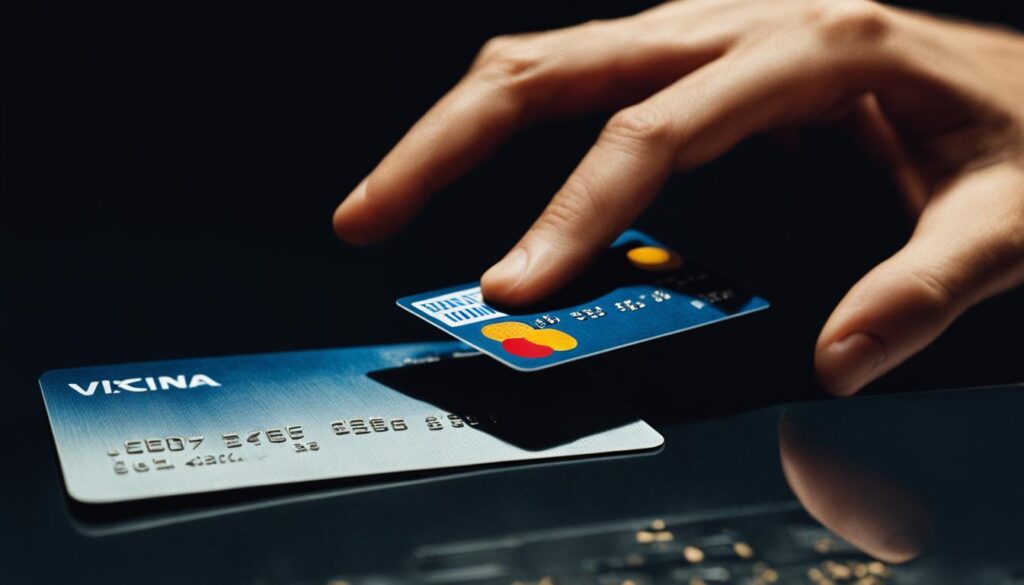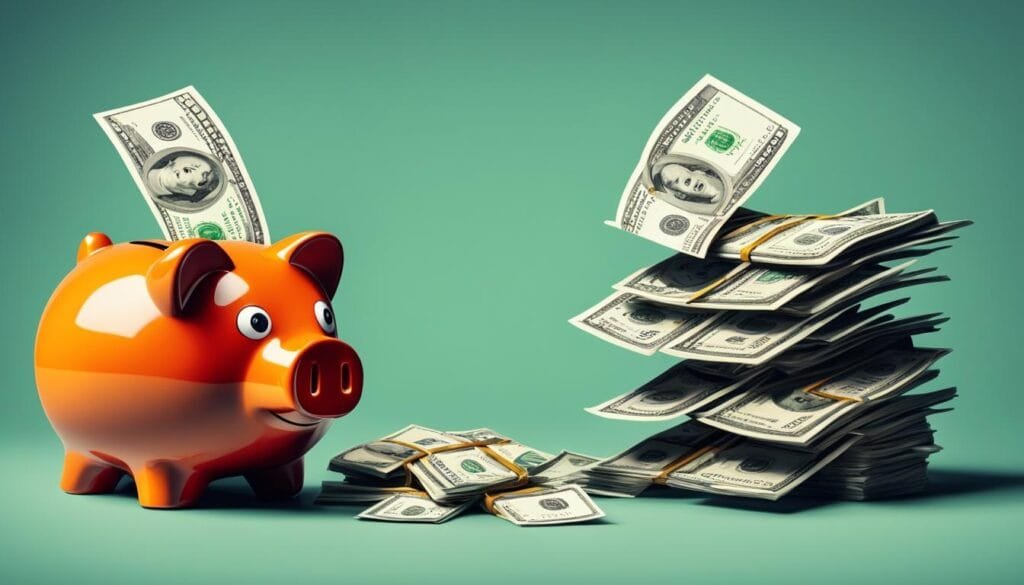The credit industry employs various marketing tactics to influence consumers and drive them into debt. These tactics can be misleading and enticing, leading individuals to make poor financial decisions. Understanding these strategies is crucial for consumers to make informed choices and avoid falling into a cycle of debt.
Credit card companies often use tactics such as introductory low APR rates, offering additional services free for a limited time, and incentives and rewards to attract new customers. However, these tactics may come with hidden fees, penalties, and high interest rates, trapping individuals in a downward spiral of debt.
Key Takeaways:
- Credit card companies employ various marketing tactics to drive consumers into debt.
- Introductory low APR rates can lead to higher interest charges and hidden fees.
- Additional services offered free for a limited time may distract consumers from high late fees and penalties.
- Incentives and rewards can encourage spending and overlooking the overall cost of maintaining a credit card balance.
- Automatic credit limit increases can tempt individuals to overspend and fall into unnecessary debt.
The Dangers of Introductory Low APR Rates
When it comes to credit card tricks, one common tactic used by credit card companies is to entice new customers with low APR rates during the introductory period. These seemingly attractive rates may lure individuals into signing up for a credit card, but the dangers that lie beneath the surface should not be underestimated.
Low APR rates offered by credit card companies often come with hidden fees and penalties. Many individuals are unaware of these additional charges, only to discover them once the introductory period is over. As a result, consumers find themselves facing significantly higher interest charges, ultimately leading to increased debt.
Another pitfall of low APR rates is the impact of late payments. Late payments can trigger an increase in interest rates and result in additional fees, making it even more challenging for individuals to pay off their debts. This vicious cycle can trap consumers in a never-ending cycle of debt and financial stress.
To avoid falling into the trap of high interest rates and accumulating debt, it is crucial for consumers to exercise caution and carefully read the terms and conditions before signing up for a credit card. Taking the time to understand the fine print and asking questions about any potential hidden fees can save individuals from experiencing financial hardship in the long run.
In the world of credit cards, it’s essential to be aware of the credit card tricks employed by the credit industry. While low APR rates may seem like an attractive offer, it’s crucial to consider the long-term implications and the potential for hidden fees and late payment penalties. By approaching credit card offers with a discerning eye, consumers can make informed decisions, avoiding unnecessary debt and maintaining financial wellbeing.
Key Takeaways:
- Low APR rates during the introductory period can be misleading, as they often increase significantly afterward.
- Hidden fees and penalties associated with low APR rates can lead to higher interest charges.
- Late payments can result in additional fees and make it challenging to pay off the debt.
- Consumers should carefully read the terms and conditions to understand the potential pitfalls.
The Temptation of Additional Services
Credit card companies often entice new customers by offering free additional services for a limited time. These services, such as credit card insurance and credit monitoring, may seem beneficial, but they can distract consumers from the high late fees and penalties associated with credit card use. These additional services may create a false sense of security and lead individuals to overlook the potential financial pitfalls of credit card debt. It is crucial for consumers to stay informed and not be swayed solely by these temporary perks.

“The free additional services offered by credit card companies can be tempting, but consumers must be cautious. These perks may divert attention away from the high late fees and penalties that can quickly accumulate and wreak havoc on one’s finances.”
While credit card insurance and credit monitoring services may provide some benefits, consumers must remember that their primary responsibility is to manage their credit card debt wisely. These additional services should not be the main focus when considering the overall cost of credit card usage. Instead, individuals should prioritize paying their bills on time and avoiding unnecessary fees.
The Distractions of Free Additional Services
When consumers are enticed by free additional services, it can be easy for them to overlook the potential financial pitfalls of credit card debt. These distractions can lead to complacency and a lack of awareness about the importance of responsible credit card use. While credit card insurance and credit monitoring may offer some peace of mind, they should not overshadow the need to stay vigilant and avoid excessive late fees and penalties.
To provide a clear understanding of the distractions posed by these free additional services, the following table highlights the potential drawbacks:
| Distraction | Effect |
|---|---|
| Focus on insurance | Overlook high late fees |
| Reliance on monitoring | Discount the impact of penalties |
| False sense of security | Ignore the need for responsible credit card use |
Staying Informed and Resisting Temptation
It is important for consumers to educate themselves about the potential pitfalls of credit card debt and not be solely swayed by the allure of free additional services. By understanding the true costs associated with credit card usage, individuals can make informed decisions and avoid falling into excessive debt.
“When considering credit card offers, consumers should carefully evaluate the terms and conditions, including any potential hidden fees. It is crucial to prioritize responsible credit card use and not let temporary perks distract from the overall financial impact of credit card debt.”
By staying informed and being vigilant of the distractions posed by free additional services, consumers can make responsible financial choices and avoid the perils of excessive credit card debt.
The Allure of Incentives and Rewards
Credit card companies often entice consumers with a wide range of incentives and rewards. From bonus points to cashback offers, these rewards can seem appealing and tempting. However, it’s important to understand that these incentives ultimately benefit the credit card company by encouraging individuals to spend more and carry a higher balance.
While the allure of credit card rewards is strong, it’s essential not to let these incentives distract you from the potential financial pitfalls. Many consumers may become so focused on earning rewards that they overlook the high late fees and penalties associated with credit card use. It’s crucial to consider the overall cost of maintaining a credit card balance and assess whether the rewards are truly worth it.
To help you make informed decisions about credit card rewards, here are some key factors to consider:
- Evaluating the redemption process: Before signing up for a rewards credit card, take the time to understand how the redemption process works. Some rewards may have limitations or restrictions that make them challenging to redeem.
- Assessing the annual fees: Many reward credit cards come with annual fees. Evaluate whether the value of the rewards outweighs the cost of these fees.
- Understanding the earning potential: Different credit cards offer varying earning potentials for rewards. Assess whether your spending habits align with the card’s reward structure to maximize your benefits.
- Considering your financial goals: Take a step back and think about your long-term financial goals. Will earning credit card rewards help you achieve those goals, or could they potentially lead to unnecessary debt?
Remember, credit card rewards should be seen as a bonus rather than a primary reason for using a credit card. It’s crucial to manage your credit card usage responsibly, pay your bills on time, and avoid carrying balances to prevent late fees and penalties.

| Reward Type | Advantages | Considerations |
|---|---|---|
| Bonus Points | – Can be redeemed for various rewards – Often earn bonus points for specific spending categories | – Potential limitations on redemption options – High APR rates if carrying a balance |
| Cashback Offers | – Provides a percentage of cash back on purchases – Can be used as statement credits or direct deposits | – May have spending limits or restrictions – Potential for high APR rates |
By carefully considering the true cost and value of credit card rewards, you can make informed decisions that align with your financial goals and avoid unnecessary debt. Remember to prioritize responsible credit card use, stay informed about terms and conditions, and pay your bills on time to avoid distractions from late fees and penalties.
The Lure of Credit Limit Increases
One common tactic used by credit card companies to entice their customers is the offer of automatic credit limit increases. On the surface, this may seem like a favorable gesture, as it implies that the company trusts the customer’s financial capability. However, it is important for consumers to approach credit limit increases with caution and careful consideration.
When credit card companies increase a customer’s credit limit, it creates a larger pool of available credit that can be easily accessed. This can tempt individuals to overspend and accumulate unnecessary debt. As long as customers carry a balance each month, the credit card companies profit through interest charges and fees.
It is crucial for consumers to evaluate their spending habits and exercise financial discipline before accepting credit limit increases. They should consider whether they truly need the additional credit and if they can responsibly manage it without falling into a cycle of debt. Responsible credit card use involves only charging expenses that can be paid off in full each month to avoid accruing interest and additional fees.
By understanding the potential risks associated with credit limit increases and exercising self-discipline, consumers can maintain control over their finances and avoid falling into the trap of excessive debt.

| Pros of Credit Limit Increases | Cons of Credit Limit Increases |
|---|---|
| Provides increased borrowing power | Temptation to overspend and accumulate debt |
| Can improve credit utilization ratio | Potential for higher interest charges and fees |
| May offer flexibility for emergencies | Risk of falling into a cycle of debt |
How do Impulse Buying Triggers Contribute to Credit Industry Marketing Tactics?
In the credit industry, marketing tactics heavily rely on understanding and utilizing impulse buying triggers. By strategically incorporating these triggers into their messaging and offers, credit companies can prompt consumers to make spontaneous purchases. This impulse buying triggers article explores the powerful impact these tactics have on consumer behavior.
Conclusion
In conclusion, the credit industry employs various marketing tactics to entice individuals and drive them into debt. However, consumers need to be aware of these credit card tricks and exercise consumer awareness to make responsible credit card use.
By understanding the tactics used by credit card companies, individuals can make informed decisions and avoid falling into excessive debt. It is crucial for consumers to read the fine print, be vigilant about hidden fees and penalties, and carefully consider the overall cost of maintaining a credit card balance.
Responsible credit card use begins with consumer awareness and a thorough understanding of the potential pitfalls. By being proactive and informed, individuals can protect themselves from the misleading tactics of the credit industry and navigate their financial journey responsibly.
FAQ
What marketing tactics does the credit industry use to get you into debt?
The credit industry employs various marketing tactics such as low APR rates, free additional services, incentives and rewards, and credit limit increases to entice consumers into debt.
What are the dangers of introductory low APR rates?
Introductory low APR rates can be misleading as they often increase significantly after the initial period, leading to higher interest charges. Consumers may also be unaware of the hidden fees and penalties associated with these rates.
How do free additional services tempt consumers into debt?
Credit card companies often offer free additional services such as credit card insurance and credit monitoring. While these services seem beneficial, they may distract consumers from the high late fees and penalties associated with credit card use.
What is the allure of incentives and rewards?
Credit card companies offer incentives and rewards such as bonus points and cashback offers to encourage consumers to spend more. However, consumers should be cautious and not overlook the high late fees and penalties associated with credit card use.
How do credit limit increases lure individuals into debt?
Credit card companies often offer automatic credit limit increases, which can tempt individuals to overspend and accumulate unnecessary debt. As long as individuals carry a balance each month, the credit card companies profit.
How can I avoid falling into excessive debt?
To avoid excessive debt, consumers should read the fine print, be aware of hidden fees and penalties, and consider the overall cost of maintaining a credit card balance. Practicing responsible credit card use is crucial in making informed decisions.
Source Links
- https://typeset.io/questions/what-are-the-marketing-techniques-that-the-credit-industry-3ai7vrz4kv
- https://www.schwartzbankruptcy.com/blog/common-credit-card-marketing-tricks-to-bait-consumers-into-debt/
- https://medium.com/@englishthea71/tricks-the-credit-card-companies-use-to-get-people-into-debt-f06c85bf39c8

